Wingspan 77 – 100 cm | Higher classification Accipiter | |
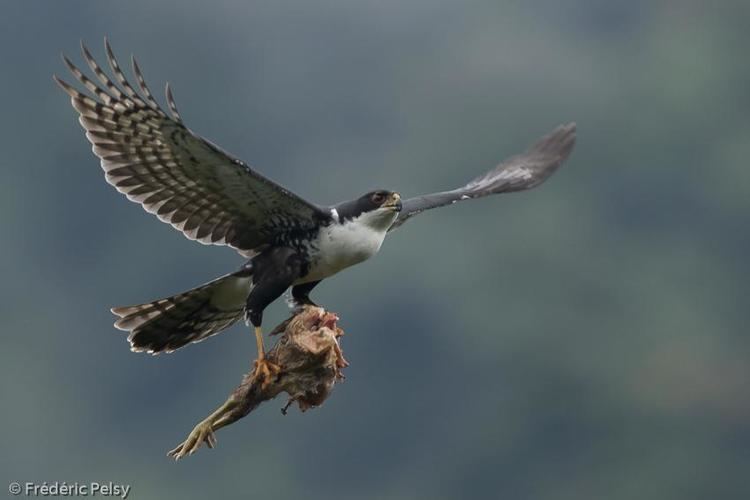 | ||
Mass Female: 750 – 980 g, Male: 450 – 650 g Similar Bird, African goshawk, Ovambo sparrowhawk, Little sparrowhawk, Rufous‑breasted sparrowhawk | ||
Black sparrowhawk feeding on dove filmed by greg morgan
The black sparrowhawk (Accipiter melanoleucus), sometimes known as the black goshawk or great sparrowhawk, is the largest African member of the genus Accipiter. It occurs mainly in forests and non-desert areas south of the Sahara, particularly where there are large trees suitable for nesting; favored habitat includes suburban and human-altered landscapes. It preys predominantly on birds of moderate size, such as pigeons and doves in suburban areas.
Contents
- Black sparrowhawk feeding on dove filmed by greg morgan
- Black sparrowhawk accipiter melanoleucus
- Description
- Size
- Taxonomy
- Habitat and Distribution
- Vocalizations
- Diet
- Reproduction
- References
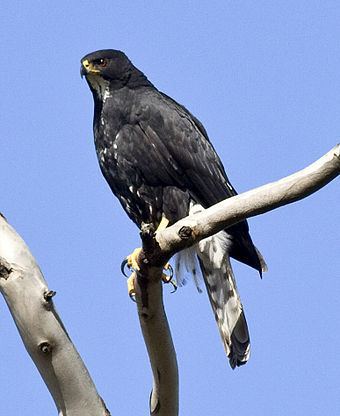
Black sparrowhawk accipiter melanoleucus
Description
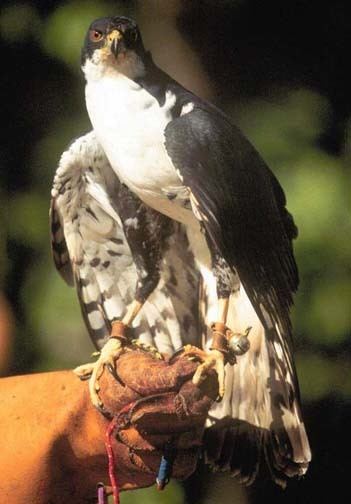
Typically, both genders of the black sparrowhawk are pied black-and-white when mature; generally the plumage is predominantly black, but with a white throat, chest and belly. These white fronted individuals are known as "white morphs" who are in the majority over most of the birds' range. The "black morph" variety is generally rare, except along the coastal regions of South Africa, including the Cape Peninsula where they constitute 80% of the population. (Black sparrowhawks do not occur more than about 200–300 km north of Cape Town along the South African west coast, where there are almost no trees.) These "black (or dark) morphs", when seen perched, can be black all over, but more commonly have black fronts with a few white spots on the chest, and a white throat of variable size. In flight both morphs show white and black barring on the underside of the wings and tail (see picture below). The black morphs are not melanistic, as commonly alleged, as their plumage is not completely black, nor are they black as chicks or juveniles. There is no noticeable difference between the plumage of mature females and males, who can only be distinguished by size. The tails are cross-barred with about three or four paler stripes, and the undersides of the wings with perhaps four or five. The legs are yellow, with large feet and talons.
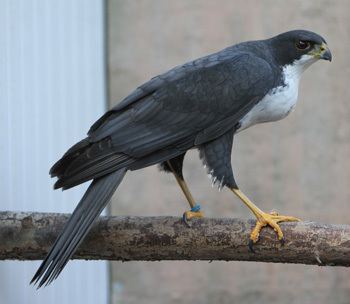
Young chicks have mid-grey eyes and white down, but when the feathers erupt they are predominantly brown. The full plumage of juveniles is a range of browns and russets with dark streaks along the head and, more conspicuously, down the chest. Commonly there are white or light-colored spots and streaks as well, mainly on the wings. The brown plumage being a sign of immaturity, it does not attract as dangerously aggressively territorial behavior as a mature black-and-white bird would. As the young birds mature, their eyes change in color from mid-grey, though light brown, to dark red.
Size
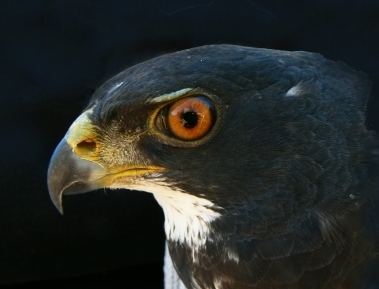
The black sparrowhawk is one of the world's largest Accipiters, only the Henst's, Meyer's and the northern goshawk can match or exceed its size. As is common in the genus Accipiter, male black sparrowhawks are smaller than females. Typically the weights of males lie between 450 and 650 g (0.99 and 1.43 lb) as compared to females, which have weights in the range 750 to 1,020 g (1.65 to 2.25 lb). The typical total length is about 50 cm (20 in) and wingspan about 1 m (39 in). As in most Accipiters, the tails are long (about 25 cm (9.8 in)), as are the tarsi (about 8 cm (3.1 in). The features of the black sparrowhawk (and Accipiters in general) are reflective of the necessity to fly through dense arboreal habitats, although this species does most of its hunting in open areas (usually from a concealed perch in a tree).
Taxonomy
There are 2 subspecies of the black sparrowhawks: Accipiter melanoleucus melanoleucus, which was named by A. Smith in 1830, and Accipiter melanoleucus temminckii, which was named by Hartlaub in 1855. As described in the next section, the 2 subspecies occur in different regions of Africa and both belong to the genus Accipiter in the family Accipitridae along with other well-known members such as hawks and eagles, all of which are part of the Falconiformes order.
Habitat and Distribution
Black sparrowhawks are relatively widespread and common in sub-Saharan Africa and listed as not globally threatened by CITES. Densities range from one pair per 13 square kilometers in Kenya to one pair per 38-150 square kilometers in South Africa. On the Cape Peninsula, however, in the south-western corner of South Africa, the nest are typically only 500 m (550 yds) apart in the pine plantations and other continuous or semi-continuous belts of trees.
Both subspecies are only found in parts of Africa that are south of the Sahara desert; A. m. temminckii inhabit much of the northwest section such as Senegal, the Democratic Republic of the Congo, and Central African Republic, while A. m. melanoleucus can be found starting from the northeast section down to South Africa. They naturally inhabit patches of forests, rich woodlands and riverine strips extending into dry bush areas. They can be found in many areas as long as they have large trees, including mangroves in coastal Kenya. Especially in southern Africa, black sparrowhawks have adapted to stands of the non-indigenous eucalyptus, poplar, and pine, all of which are grown commercially and are able to grow up to 15 m (49 ft) taller than native trees. Their adaptability to secondary forests and cultivations (they are not uncommon around homesteads now) is one of the reasons why they are not as greatly impacted by deforestation as many African forest birds and may actually increase populations where such stands have been placed in otherwise open country. They can be found in elevations from sea-level to 3,700 m (12,100 ft).
The south and westwards range expansion of black sparrowhawks in South Africa has led them to colonise the urban and suburban areas of Cape Town where they have thrived in the past 15 years, with none of the expected negative impacts on their health that might have been expected from the disturbances associated with a novel climate (from a subtropical, summer rainfall regimen to a Mediterranean, winter rainfall region), or other possible sources of stress in their newly urbanised environments. This is probably due to the abundance of prey, mainly various species of Columbidae (the wide variety of pigeons and doves) in these urban areas, and, therefore, their lack of nutritional stress.
In some areas such as Cape Peninsula, the sparrowhawks face habitat competition with Egyptian geese (Alopochen aegyptiaca), an aggressive species known to steal the nests of the sparrowhawks. This results in a costly loss for the sparrowhawks after the time and energy spent building the nest and may also lead to the death of current offspring. However, sparrowhawks occasionally have more than 1 nest at a time, or they can readily build a new nest, so, in the event that one is usurped by an Egyptian goose, the pair will sometimes start breeding again in a nearby alternative nest; or they might wait until the geese have left the nest with their goslings, or they abandon breeding for that year.
Vocalizations
Normally silent except during the breeding season. Males make short, sharp "keeyp" contact calls when arriving with prey, to which the females respond with lower pitched "kek" sounds. Before the male arrives with food, however, the female will solicit food with loud, high pitched drawn out "kweeeeee-uw" sounds. Both genders make alarm calls, and characteristic mating cries. The chicks, but especially the juveniles, are very noisy making high pitched "weeeeeeeeh" sounds, especially when soliciting food.
Diet
Black sparrowhawks prey primarily on mid-sized birds. Most prey is spotted from a foliage-concealed perch and then is killed in flight while on a short flying dash. Less often, they stoop or chase prey seen during low or high flight over open country or near the canopy of trees and, in some cases, may even pursue prey on foot. Although kills are often made in under a minute after the initial attack, occasionally this species may engage in a prolonged pursuit over several minutes. They have been known to scan for antswarms so they can predate birds attracted to them. Most birds preyed on by this species are in the size range of 80–300 g (2.8–10.6 oz). However, they have taken guineafowl weighing up to 1.5 kg (3.3 lb). Doves are the primary prey of males, whereas females take a greater quantity of larger prey such as pigeons and francolins. They also feed on poultry found in rural villages, which have been inadvertently made available to them by humans. They also often take species such as rock pigeons that have flourished due to urban growth and settlement. It is, in fact, one of the species that have been able to adapt to a changing habitat due to afforestation and urbanization by taking advantage of the increase in dove and pigeon populations. With some regularity, they prey on other raptor species, including shikra, Ovambo sparrowhawk, African goshawk and wood owl. Very occasionally, they may supplement their diet with small mammals, such as bats, rodents and juvenile mongooses. Black sparrowhawks can carry their plucked, and decapitated prey up to 12 km (7.5 mi), usually well above the canopy.
Reproduction
A. m. temminckii usually breed between August and November while A. m. melanoleucus breed between May and October. In Zambia, they breed at an intermediate time, between July and February. Black sparrowhawks in eastern Africa seemingly breed at almost any time of the year. These birds are particular about their nest sites; they prefer sites within the tree canopy to protect their offspring from adverse weather conditions and other predators. Nests have been found from 7 to 36 m (23 to 118 ft) high in trees, though (in rare cases) have been found on the ground between large tree trunks. However, the nests are usually not deep within the forest in order to stay within close proximity of the hunting habitat outside of the forest.
The nests are made up of thousands of sticks collected by both parents and are usually lined with green eucalyptus leaves, pine needles, camphor leaves or other aromatic greenery possibly to deter carriers of diseases, such as mites and insects, due to the repelling smell of the leaves, though greenery is often put in place weeks before the first egg is laid. The nests can measure from 50 to 70 cm (20 to 28 in) in width and 30–75 cm (12–30 in) deep.
Black sparrowhawks form monogamous pairs, though extra-pair matings are not uncommon. A nesting pair will mate regularly throughout the breeding season, starting during courtship and continuing till after the chicks have fledged. Once nest building or refurbishing starts the female becomes lethargic, and the male does nearly all the hunting and provisioning of the female and the chicks when they hatch. Typically, a pair will lay 2-4 eggs and incubate them for about 34–38 days until they hatch. Most of the incubating is done by the female, but the male will take over after he has brought in prey. The female will then eat the food, and possibly bathe in a nearby stream, before taking over the incubation once again. This behavior persists into the brooding period, after which the female may also start to hunt for food, but only if the nest is left largely undisturbed by other predators. She remains the chief defender of the nest and the chicks. The newly hatched chicks are semialtricial in that they are fully covered in white down feathers but cannot leave the nest since they rely on the parents for food, warmth, and protection. After 37 to 50 days, the juveniles are fledged but the parents will continue to care for them for the next 37 to 47 days. The entire time from egg-laying to the juvenile independence can, therefore, be 20 weeks, or 5 months.
Black sparrowhawks are known to attempt multiple brooding on occasions. This behavior is exceeding rare in birds of prey. The second brood may be raised in the same nest, or in a second nest nearby, where the fledglings from the first brood will continue to be fed by the parents.
Nests are usually re-used year after year, frequently by the same pair. One nest is, in fact, known to have been used continuously for 32 years by a succession of pairs.
